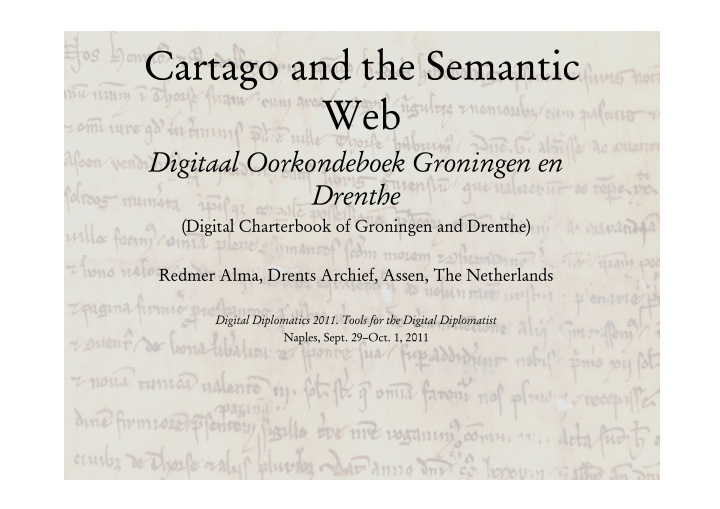



Cartago and the Semantic Web Digitaal Oorkondeboek Groningen en Drenthe (Digital Charterbook of Groningen and Drenthe) Redmer Alma, Drents Archief, Assen, The Netherlands Digital Diplomatics 2011 . Tools for the Digital Diplomatist Naples, Sept. 29–Oct. 1, 2011
Groningen Drenthe Belgium Belgium
Initial situation •Lack of archival sources (few (city) accounts, judicial registers, feudal sources) •Deeds relatively very important •Until 1600 ca. 15.000 deeds: publication is possible •Sources until 1405 published in Oorkondenboek van Groningen en Drente (1896- 1899)
Cartago, phase 1 (2003-2008) • Publication of all 15.000 deeds in the regional archives of Groningen and Drenthe prior to Jan. 1, 1601 • Images, transcripts and descriptions • Advanced searching techniques (broad public) • Professionals (scholars and archivists) and amateurs • Integrated advanced content management • No (or hardly) analysis of content • Digital publication
Cartago, phase 1 (2003-2008) • Cooperation between Groninger Archieven, Drents Archief and Rijksuniversiteit Groningen • € 500.000, mostly from private funds
• Oct. 1, 2008 (phase 1): 33.980 deeds (original, copy, edition) 66.903 scans • Jan. 1, 2012 (addition of the Groningen City Archives): 156.422 scans (incl. deeds, accounts, judicial registers etc.)
Cartago A brief introduction…
Searching •Give insight in the way data are disclosed (‘Opening the Black box’) •Implications for datastructure
Combined searching •First name •Surname •Toponym •Region/country •Function •Keyword (a.o. function)
Cartago Presentation: Images, transcripts and descriptions
Id Date Archival reference Traditio n Abstract Transcrip t Pictur e Navigation tools
Additional information
Source
Front (Back) (Translation )
Relation
Authenticatio n Photo
(Literature/editions) Material
Index entries
Cartago Integrated advanced content management
Check logs Make index Transcribe Export Report Import Check Print Edit
Cartago Edit function
Cartago Export and import function
Selection Fields
Selected fields Error
Import of file
Cartago Transcribe
Transcribe
Cartago Check logfile
Conclusion (part 1) •System on itself, aimed at presentation •Repository •Built in 2005; evaluation is needed •Structure preliminary; formalisation needed •By archivists, for broad public •Large number of deeds •Mostly already available metadata •Permanent URL ( www.cartago.nl/oorkonde/fae398 )
And now… •Evaluation (functionality, searching, usability, design, contentmanagement) •Formalization of metadata •Evaluation of datastructure (e.g. dates, keywords, relations between different metadata) •Adapt for use by others
Why? •Current structure insufficient •Not only deeds, but also other sources •Use by other archives and institutions •Cartago is only larger Dutch charterbook
What has Cartago to offer? •Archivistic roots •Experience with large numbers •Elaboration of theoretic concepts •Will to move on
Cartago and the Semantic Web Digitaal Oorkondeboek Groningen en Drenthe (Digital Charterbook of Groningen and Drenthe) Digital Diplomatics 2011 . Tools for the Digital Diplomatist Naples, Sept. 29–Oct. 1, 2011
Cartago
Levels 1. Higher (RDF, DC, EAD, TEI) 2. Same (MOM-CA/CEI) 3. Lower (Formalisation metadata) 4. Relations as entities
Cartago Examples
Date fields datering: literal date clause (‘up Cruces Vindinge dach’) datum: normalised (‘3 mei 1400’) jaar: year (‘1400’) deviatie: possible deviation (‘0’) datumcode: coded date (‘InvCru’)
Datumcode Inventionis Crucis: InvCru Lunae die post Inventionis Crucis: LpInvCru Vigilia Inventionis Crucis: vInvCru Crastina Inventionis Crucis: cInvCru etc.
Additional wishes •Only one date (issue, seal, registrated, received, copy, valid time, date mentioned) •No year style (Christmas, Eastern, Annunciation etc.) •Uncertainty •Possibility vs. probability
Names •jonge – Johan – de – Brouwer – to Stedum •Groningen/Drenthe, 1400-1600 •Not individualised
Names •Huge problem, huge impact (other archival sources; many user interfaces) •Core business of archives •Extension of generic solution •NEI?
Relations between objects •Vidimus •Transumpt •Transfix •Copy ((in)dependent) •Part of description of object (‘A copy of B’; ‘Copy of A: B) •Cartago 99% private charters •Reconstruction original • Discrimen veri aut falsi
And more… • Transcription rules and conventions • Description of material • Bibliographical references • Former archival refences • Etc.
The archivist’s point of view •Serial sources for material •Preliminary identification •Tagging
Conclusion •Cooperation necessary •Diplomatics and auxiliary sciences (SEI, DEI, PEI, AEI) •Standardisation •Anticipate
Don’t ask what the semantic web can do for you, but ask what you can do for the semantic web
Recommend
More recommend